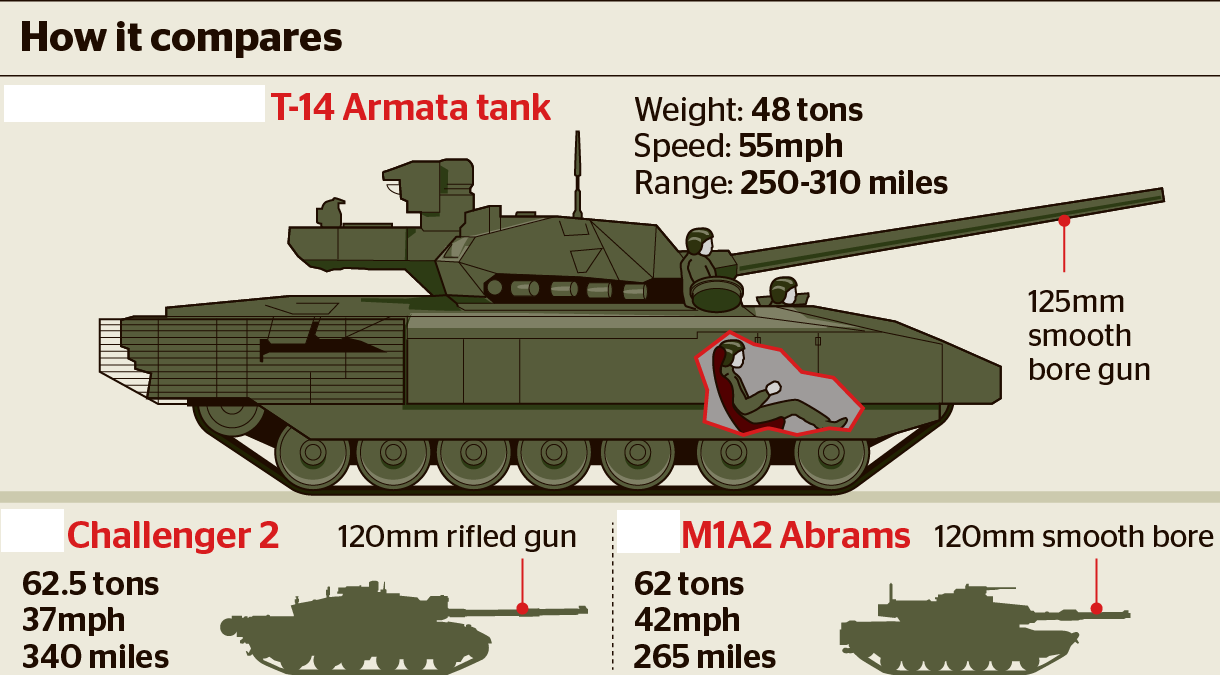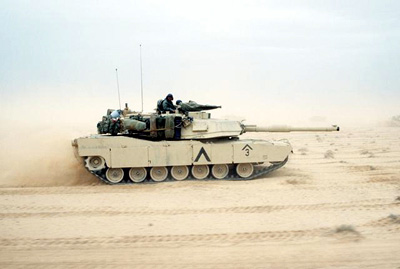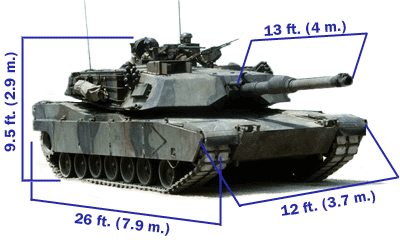| What is the best main battle tank in the world? |
T-14 Armata
Designer / Ural Design Bureau of Transport Machine-Building, Uralvagonzavod
Manufacturer / Uralvagonzavod

|
What is a tank made out of?
Basic Tank Parts
|
Light Tanks: Built for speed Medium Tanks Heavy Tanks: The Bruisers Tank Destroyers: Overwatch |
| Compare Systems |
| Battle Tanks |
 |
 |

|
|
M1 Abrams battle tanks
M1 crew. The M1 is the world's preeminent tank because it combines four crucial qualities: * Superior mobility - to get to targets and escape attack * Superior sensors and controls - to locate and hit targets * Superior firepower - to destroy targets * Superior armor - to withstand attack Basic Tank Parts The final design had six components: * Caterpillar tracks * Internal combustion engine * Hull * Turret * Armor * Guns Caterpillar tracks work on the same principle as a conveyer belt. The tank engine rotates one or more steel sprockets, which move a track made up of hundreds of metal links. The tank's wheels ride along the moving track, just like the wheels in a car run along the road. Earlier tracked vehicles weren't practical in battle because their steam engines were too cumbersome and unreliable. The internal combustion engine made tracked military vehicles feasible. Tracked vehicles can move easily over rough terrain because the track makes contact with a wide area of the ground. A car grips the ground with only the bottom portion of four tires, but a tank grips it with dozens of feet of track. Additionally, the track has heavy tread that digs into muddy surfaces, and it never goes flat like a tire. The hull is the bottom portion of the tank -- the track system and an armored body containing the engine and transmission. The hull's job is to transport the top portion of the tank, the turret, from place to place. The turret is an armored structure supporting one or more guns -- typically a heavy cannon and a couple of machine guns. m1 tank v The M-1 tank has two main parts: a pivoting gun turret and a tracked hull. The turret sits in a wide circle at the center of the hull. In the conventional design, a spur gear in the hull (called the traverse gear) engages an internal gear lining the inside of the turret. Turning the traverse gear rotates the turret on the hull, allowing the tank crew to aim the main gun without turning the entire tank. The crew can also pivot the main gun up and down. Soon after the British deployed their new weapon, the Germans developed tanks of their own. With tanks on both sides, the weapon's role changed significantly. Instead of taking out trenches, today's tanks mostly battle other tanks. As we'll see in the next few sections, the M1 is specifically designed for this sort of combat. The M1 Tank Engine The M1 uses a 1,500-horsepower gas turbine engine to achieve high mobility. Gas turbine engines have a much better power-to-weight ratio than reciprocating engines. That is, they provide a lot more power without adding a lot of weight. Turbine engines are also a lot smaller than comparable reciprocating engines, so you can do more with the available space on the tank. The low-weight, high-power turbine engine lets the M1 move faster and maneuver better than most comparable tanks. According to General Dynamics Land Systems, the tank can accelerate from 0 to 20 miles per hour in 7.2 seconds, and it can safely travel 30 miles per hour cross-country. The high speed and agility do come at a price, however: Even with an advanced digital fuel control system, the tank gets less than a mile per gallon! The most recent M1 model holds 490 gallons (1,850 L), allowing the tank to go about 265 miles (426 km) without refueling. The turbine engine works with a range of fuels, including ordinary gasoline, diesel fuel and jet fuel. The engine provides power to a six-speed automatic hydrokinetic transmission (that's four forward gears and two reverse gears). The transmission turns sprockets on either side of the tank. The sprockets pull the track along. M1 Weapons The M1's primary weapon is a 120-mm M256 smoothbore cannon made by the German company Rheinmetall Landsysteme GmbH. The "120-mm" designates that the cannon fires 120-mm-wide rounds. "Smoothbore" means the inside of the barrel is smooth, rather than rifled like most hand guns. Smoothbore guns don't stabilize rounds as well as rifled guns, but they can fire rounds at higher velocities without suffering heavy damage. M1 tank's main weapon is a 120 mm smoothbore cannon The M1's main weapon is a 120-mm smoothbore cannon. The M256 fires a variety of training rounds and combat rounds. Its two main combat rounds, generally known as sabot and HEAT rounds (for high-explosive anti-tank), inflict damage in very different ways. Sabot Sabot rounds work like a basic arrow. They don't have any explosive power; they penetrate armor with shear momentum. The heart of the sabot round is the penetrator -- a narrow metal rod (typically depleted uranium) with a pointed nose on one end and stabilizing fins on the other. Before the round is fired, the rear part of the penetrator is attached to a propellant case, and the front part is attached to the sabot structure. The sabot's purpose is to keep the narrow penetrator centered in the wide gun barrel. On firing, the propellant casing remains in the chamber, and the expanding gas pushes the sabot and attached penetrator down the barrel. The sabot is attached to the penetrator with relatively flimsy plastic, so it falls away as soon as the round leaves the cannon. The heavy penetrator flies through the air at high speed toward its target tank. Because of its narrow shape, the penetrator focuses its full force into a very small area, plowing straight through heavy armor. As the penetrator enters the tank, heated fragments of metal fly off in all directions, hitting anybody and anything inside. M1 sabot The sabot separates from the penetrator as a sabot round flies through the air. HEAT HEAT rounds use explosive firepower, rather than momentum, to penetrate armor. At its nose, the round has an extended impact sensor. When the impact sensor collides with a target, it ignites an explosive, which melts surrounding copper. A shape charge liner concentrates the molten metal and hot gases into a narrow blast that cuts through the armor. The M1 also has three machine guns. It has a Browning .50-caliber M2 and a 7.62-mm M240 mounted to cupolas on the top of the turret, and another M240 mounted next to the main gun. M1 .50-caliber machine gun The M1 tank's .50-caliber machine gun The coolest thing about the M1's weaponry is its advanced fire control system. An array of sensors constantly monitors the tank's tilt, the turret's motion and any gusts of wind, and a computer adjusts the gun accordingly to keep it aimed at its target. With this system, the M1 can take out other tanks while it's on the move. Less sophisticated tanks have to come to a full stop to hit targets reliably. M1 Armor The M1 is mainly composed of sturdy rolled homogeneous armor (RHA) steel plates, sandwiched around thicker protective material. The core armor is a variation on the British Chobham armor -- an arrangement of metal plates, ceramic blocks and open space. HEAT and Sabot rounds may make it through the outer layer of the armor, but they won't make it all the way into the crew compartment. The ceramic material can absorb a lot of heat, as well as heavy physical blows. The rest of the hot gases or metal pieces spread out in the empty air pockets. v Updated M1 tanks have extra layers of steel and depleted uranium that supplement the Chobham-style armor. This combination will hold up to any tank round and most missiles (the powerful Hellfire missile is a notable exception). The crew keeps the M1's rounds in heavily armored storage compartments. If something sets the ammunition off, the armored structure keeps the explosion from blasting the crew or completely destroying the tank. An onboard fire suppression system will quickly extinguish any fires that occur inside the tank. The M1 is also equipped to handle chemical or biological attack. An advanced air filter system purifies all air coming into the tank so the crew isn't at risk. The tank can avoid attack entirely by hiding from the enemy. The tank has two turret-mounted grenade dischargers designed to launch smoke grenades in all directions. The crew can also inject a little diesel fuel into the exhaust to generate a cloud of heavy smoke. In the next section, we'll look at the members of an M1 crew and the jobs they do. M1 Crew The M1 is designed for a four-person crew. The driver sits in the front section of the hull, directly under the main gun. In order to fit in the confined space, he has to lean way back in a reclining, form-fitting bucket seat, sort of like a dentist chair. M1 crew members say that this is far and away the most comfortable position in the tank. The driver steers the tank using a motorcycle-style handlebar, and accelerates by twisting a handle grip throttle. The tank has a brake pedal on the floor, just like a car. M1 tank In the M1, the driver sits in the front of the tank hull. The driver navigates using three periscopes (also called vision blocks). For night operations, he can substitute a night vision sensor for one of the ordinary periscopes. The driver also has a digital instrument panel, called the driver's integrated display (DID), which provides navigational data, as well as information about things like speed, fluid level and engine performance. The rest of the crew works in the turret basket (the turret's interior compartment). The loader rides on the left side of the turret, toward the back; the gunner rides on the right side, towards the front; and the commander rides on the right side, towards the back. M1A2 display A tank gunner examines the commander's display unit on the M1A2. The commander oversees the tank's operation, communicates with other tank commanders and directs the rest of the crew. He has several periscopes and a joystick-controlled independent thermal night vision viewer to survey the battlefield. He can monitor the tank's various systems and its position on his integrated display. The gunner targets __________ and bunkers and fires the main gun. He pinpoints targets using a stabilized sight, with day vision and thermal night vision capabilities, and a laser range-finder that precisely measures the distance to the target. He also controls the front machine gun and monitors the main gun's general condition. The loader pulls rounds from the ammunition compartment and load them into the main gun. Generally, the gunner tells the loader which sort of round to load. The loader and commander may also operate the two machine guns mounted on top of the turret. On the M1A2, they have to open the tank's two hatches and fire the guns manually, so it's not a viable option in a tank battle. The machine guns are mainly for attacking infantry soldiers. All of the M1s on the battlefield are linked together by the inter-vehicle information system (IVIS). Using IVIS, commanders keep track of the other tanks' positions, transmit maps and share information about the enemy. In order to hide communications from the enemy, the system uses encrypted radio signals. The combination of these advanced electronics, incredibly strong armor and massive firepower make the M1 an almost unbeatable opponent in tank warfare. But evolving technology will eventually surpass the M1, and the weapon will take its place alongside the dozens of other tanks that have come and gone over the years. In the world of military science, technological superiority has a short life span. |
